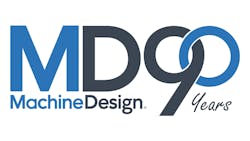As part of Machine Design’s 90th anniversary issue in January, we’ve asked industry experts to take a look at the present and future of technology and how it will impact the design and operation of manufacturing over the next decade.
Q: What products do you see that are currently solving design engineers’ problems?
Frattarola: Design and manufacturing simulation tools continue to improve each year, enabling designers to model their products and test them within a virtual environment. This has greatly improved development time compared to just 10 years ago, when significant time, money, and resources were necessary to build and test prototypes.
At Southco, we use industry recognized engineering programs that allow us to get our products to market quicker with less quality issues. CAD/CAM tools for instance, have evolved to the point where we can use simulation tools to do kinematic analysis and finite element analysis to assure we are meeting strength criteria.
Additive manufacturing (3D printing) is revolutionizing the time it takes to bring products to market as well. Companies are leading the way with 3D printers capable of printing fiberglass reinforced and carbon fiber parts. These parts are just as strong as or stronger than injection molded plastic parts, with an appearance that rivals molded parts.
This technology is being used to not only print out product and prototypes, but also tools, jigs and fixtures that would normally be made in a machine shop at many times the cost.
Metal 3D-printed parts are being used to build tooling to produce parts faster and at a lower cost than cutting metal in a machine shop. Mold cavities for plastic, zinc, and aluminum die cast can be metal printed with conformal cooling channels that could never be machined by conventional methods. As a result, quality can be improved throughput in the process.
Advances in high-strength plastics and steels are allowing designers to design and manufacture products that are lightweight to improve fuel efficiency and not drain our planet’s natural resources. These products have lighter weight but the same strength to meet aerospace and automotive industry guidelines for passenger safety. Automakers and original equipment manufacturers are making greater use of advanced high-strength steels, which are lighter and stronger. The newer steels require different factory equipment because of their strength.
Countries with high-cost labor have issues with assembling and packing product and being competitive with low-cost countries. Recent tariff issues have leveled the playing field somewhat but hiring people to do simple, repetitive operations is difficult and turnover is high. Also, many tasks, such as removing hot parts from casting machines, welding and painting expose workers to hazards, safety issues, and unsafe airborne toxins. Cobots offer a solution to this problem.
A cobot is a robot that can work safely next to humans vs. needing to be enclosed in a cage. They are becoming more widely used in manufacturing because they can sense their surroundings and work without touching other machines, robots, or people in their immediate area. Cobots are also becoming smarter and more efficient, which means that the cost of using them is also coming down. In less than five years, most monotonous or hazardous tasks in the manufacturing industry will be replaced by robots and cobots.
Q: How are the products and innovations changing the manufacturing landscape?
Frattarola: The design products available today allow ideas to be prototyped and tested in real time, allowing us to gather customer feedback faster than ever before so that problems are resolved before large capital is spent on factory space, equipment, and tooling.
The world is now becoming globally connected to the IoT. Our factories and machines are connected, and we are connected with our customers. For example, a customer can place an order on Southco’s web store, which then automatically triggers an order that is retrieved automatically by a warehouse picking system and shipped within the same day.
We can monitor equipment capacity and efficiency globally, and when we run out of a product in one facility, we can route the orders to another location where we have capacity. This is the beauty of being part of a connected world. Some of our products offer connectivity as well.
Our customers are looking for access hardware that connects with their existing building security badges, smartphones, and biometric systems. We need to be able to quickly connect with these systems without adding cost for the customer.
For example, automakers want to use the same fob used for keyless door locking and ignition to open a locked glove box or rear access compartment within the vehicle. In datacenters, maintenance personnel must use the same user credentials to access the server cabinet they are servicing as they did to get into the building, with compliance regulations requiring an audit trail that records who accessed the equipment, when, and how long. These are all functions of our connected world.
Q: How do you see the future? How will products/solution evolve?
Frattarola: The future of design is wide open, and what is most exciting about this is that technology does not evolve in a linear fashion. It will continue to evolve exponentially; what is considered new today will quickly be replaced by amazing technology that we have not yet thought of or even anticipated a need for.
Companies that are slow to adapt will not be here in the next 100 years. Kodak, for example, invented the digital camera but could not let go of the legacy film business. Likewise, most people today take pictures on their smartphones, which has made the traditional camera almost obsolete for the common person.
Many companies get caught up in the present and neglect to look into the near future. As a privately held company, Southco has more freedom to think of long-term strategies. We have dedicated teams that look into technologies not yet in use today that could potentially benefit our company and customers tomorrow.
Q: What is the biggest hurdle engineers or manufacturers will face moving forward in the next decade?
Frattarola: The biggest hurdle facing engineers and manufacturers will be the challenge of being flexible and adaptable enough to keep up with the speed of technology and future changes. Those who cannot keep up will end up losing their market share.
Over the last 100 years, it took a lot of financing and capital to start a company. Today, all that’s needed is an internet connection and a great idea to create, market, and promote a new company start-up or product. It will be a challenge for older companies steeped in bureaucracy and red tape to keep up with that kind of speed and tolerance for failure. Attitudes of larger companies that have led the way in the last 100 years will have to change and adapt if they are to survive another 100 years.
Company culture and leadership is the best way to prepare for these hurdles. At Southco, we have never laid off a person due to implementation of a cobot, or automation of a process. We have been able to redirect our people to more challenging jobs and have trained them on new skills needed to use and operate the new technologies we are implementing. If manufacturers continue to do this, people will not be afraid of technology.
History has shown that new technology has always created more jobs that in many cases have paid better than the jobs that they replaced or eliminated. Manufacturers need to create a culture where their people will embrace and adapt to changes in technology rather than fear it.
About the Author

Bob Vavra
Editor Emeritus, Machine Design and Power & Motion
Bob Vavra is the former senior content director of Machine Design and Power & Motion.

